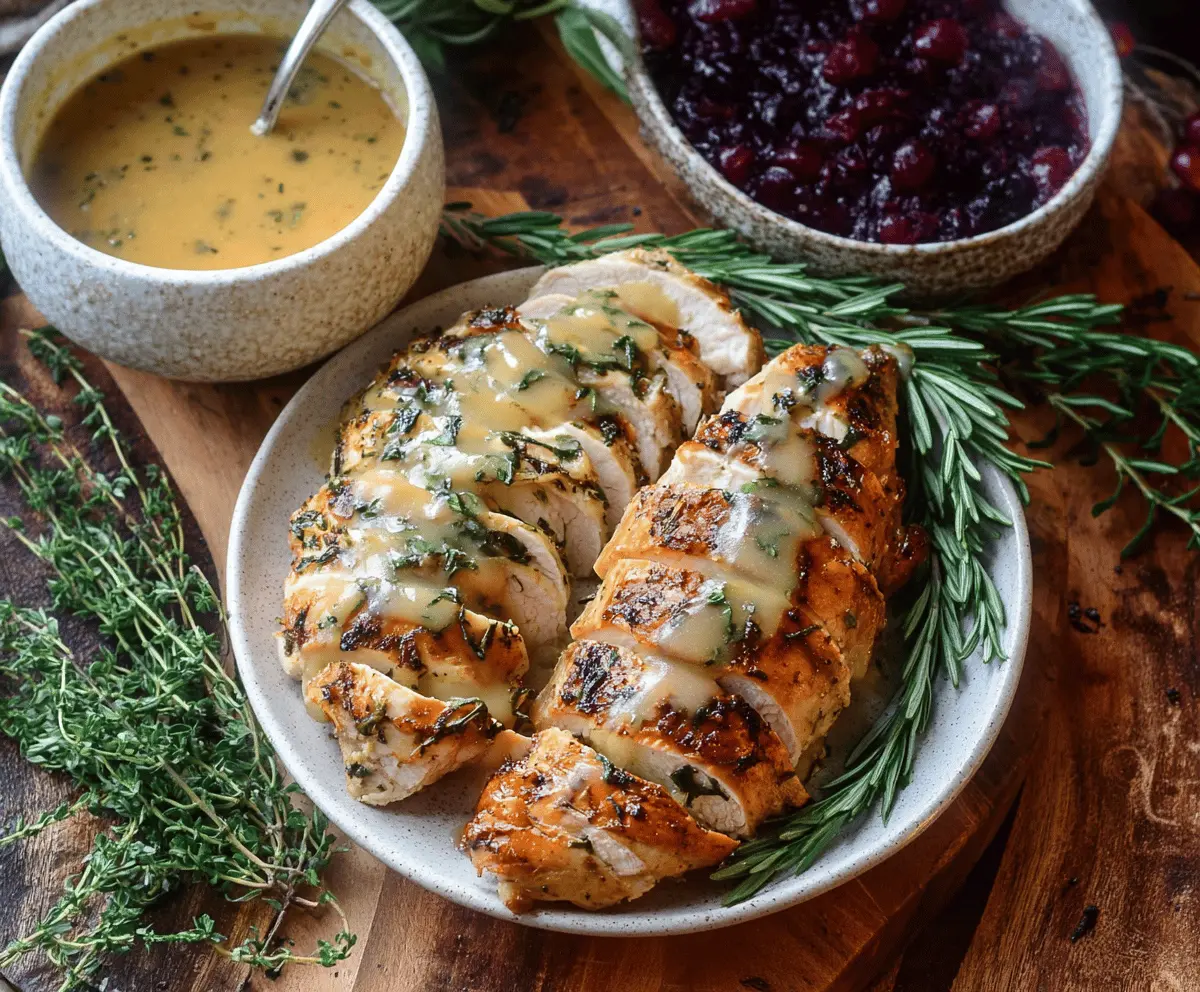Brown Butter Herb Turkey Gravy is a wonderful twist on traditional gravy that brings rich, nutty flavors and fresh herb notes together in a silky sauce. The brown butter adds a toasty depth, while the herbs give it a fragrant, earthy kick. It’s the perfect topping to make your turkey and mashed potatoes feel extra special.
I love making this gravy because the brown butter step turns an everyday gravy into something really comforting and full of character. Plus, the aroma as the butter browns and the herbs infuse is so inviting—it fills the kitchen with a warm, cozy vibe that makes waiting for dinner a little easier. I always try to have some extra on hand for seconds!
My favorite way to serve this gravy is over a big slice of turkey breast with creamy mashed potatoes and some roasted veggies on the side. It’s one of those recipes that brings everyone to the table with smiles and full plates. If you’re like me and appreciate a gravy that’s both simple and bursting with flavor, this one will quickly become a go-to in your holiday or Sunday dinners.
Key Ingredients & Substitutions
Unsalted Butter: This is the star for browning and flavor. Using unsalted butter lets you control the saltiness. If you want less fat, you can substitute half the butter with olive oil, but you’ll lose some of that toasty richness.
Turkey Drippings/Broth: Using drippings gives the gravy a deep, authentic flavor from the roasted turkey. If you don’t have drippings, turkey or chicken broth works well. For a vegetarian twist, use mushroom broth and swap butter for oil.
Fresh Herbs (Sage, Thyme, Rosemary): Fresh herbs bring brightness and fragrant earthiness. If fresh aren’t available, dried herbs can be used—reduce the quantity to about a third since they’re more concentrated.
Flour: This thickens the gravy. For gluten-free options, substitute with cornstarch or arrowroot powder—but add them later once the liquid is hot to avoid clumping.
How Do You Make Perfect Brown Butter Without Burning It?
Brown butter adds nutty depth but can easily burn if you’re not careful. Here’s my method:
- Use a light-colored pan so you can see the butter’s color change clearly.
- Melt butter over medium heat and swirl the pan gently; avoid stirring with a spoon that can break up the solids unevenly.
- Watch closely for foam, then golden-brown solids forming on the bottom—when you smell a nutty aroma, it’s time to remove the pan from heat.
- Transfer immediately to prevent carrying over and burning.
Once you master this, your gravy will have a rich, deep taste that’s hard to beat!
Equipment You’ll Need
- Medium saucepan – perfect for making the gravy with enough room to whisk without spilling.
- Whisk – helps you blend the flour smoothly into the brown butter and prevents lumps.
- Fine mesh strainer – great for straining turkey drippings to remove solids for a silky gravy.
- Heat-resistant spatula or wooden spoon – useful for stirring the roux and scraping the pan.
Flavor Variations & Add-Ins
- Swap turkey drippings for chicken drippings; it’s lighter but still tasty for everyday meals.
- Add a splash of white wine with the broth for a bright, slightly acidic note that lifts the gravy.
- Stir in sautéed mushrooms for an earthy boost—works well if you want to stretch the gravy or add depth.
- Use rosemary and lemon zest instead of sage for a fresh, citrusy twist that pairs great with roasted turkey.

Brown Butter Herb Turkey Gravy
Ingredients You’ll Need:
For the Gravy:
- 1/2 cup unsalted butter
- 2 tablespoons all-purpose flour
- 2 cups turkey drippings or turkey broth (preferably from roasted turkey)
- 1 cup chicken broth (optional, to adjust consistency)
- 2 teaspoons fresh sage, finely chopped
- 2 teaspoons fresh thyme leaves
- 1 teaspoon fresh rosemary, finely chopped
- Salt, to taste
- Freshly ground black pepper, to taste
How Much Time Will You Need?
Preparing this brown butter herb turkey gravy will take about 15 minutes after you have your turkey drippings ready. Most of the time is spent gently browning the butter, preparing the roux, and simmering the gravy until it thickens nicely.
Step-by-Step Instructions:
1. Collect and Prepare Turkey Drippings:
After roasting your turkey, pour the drippings from the pan through a fine strainer into a measuring cup. Let the fat separate and skim off about 1/2 cup of the fat (or use butter if you don’t have enough fat).
2. Make Brown Butter with Herbs:
In a medium saucepan over medium heat, melt the butter. Keep swirling the pan occasionally as the butter cooks, until it turns golden brown and smells nutty (about 4-5 minutes). Add the finely chopped fresh sage, thyme, and rosemary, and cook for 30 seconds to release their aromas.
3. Prepare the Roux:
Sprinkle the flour into the brown butter and herbs. Stir constantly with a whisk, forming a smooth paste called a roux. Cook this for 2-3 minutes until it becomes a light golden color, which helps get rid of the raw flour taste.
4. Add Broth and Simmer:
Slowly whisk in the turkey drippings, adding chicken broth if needed to reach your desired consistency. Stir continuously to avoid lumps. Bring the mixture to a gentle simmer and cook, stirring often, for about 5-7 minutes until the gravy thickens.
5. Season and Serve:
Add salt and freshly ground black pepper to taste. If the gravy is too thick, loosen it with a bit more broth. Serve immediately over sliced turkey and enjoy! This gravy also goes wonderfully with mashed potatoes and roasted vegetables.
Can I Use Frozen Turkey Drippings or Broth?
Yes! If you have frozen drippings or broth, thaw them in the refrigerator overnight. Warm slightly before using to help them combine smoothly into the gravy.
What Can I Substitute if I Don’t Have Fresh Herbs?
You can use dried herbs instead—just reduce the amount to about one-third of the fresh quantity since dried herbs are more concentrated. Add them when you cook the flour to help release their flavor.
How Do I Store Leftover Gravy?
Store leftover gravy in an airtight container in the refrigerator for up to 3 days. Reheat gently on the stove over low heat, stirring occasionally. Add a splash of broth or water if it thickens too much.
Can I Make This Gravy Ahead of Time?
Absolutely! Make the gravy and cool completely, then refrigerate for up to 2 days. Reheat slowly on the stove, whisking well and thinning with broth if needed before serving.

